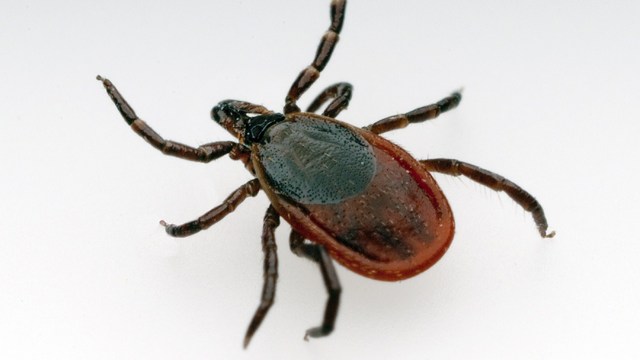 Christian Delbert/PhotoSpin
Christian Delbert/PhotoSpin
The weather is finally nice enough to enjoy the outdoors. But, unfortunately, that also means ticks are out there too. There are a number of different types of ticks that are active during spring to summer, but it is the deer tick we hear so much about because it can cause Lyme disease.
Female adult deer ticks and ticks in the immature nymph stage can transmit Lyme disease to a host. However, it is thought that nymphs more often cause the infections. The problem is that nymphs are tiny, about the size of a poppy seed, and can easily be missed once attached to your skin.
Nymphs feed during May through July so that is the time to be extra vigilant when you're going outside in the woods or grasses where they live. Nymphs feed on hosts, like mice, chipmunks or deer, but also on humans. Then they drop off into leaves and emerge in the fall as adults.
Adult females also pass Lyme disease. They are a bit easier to identify because when unfed, they have reddish-orange backs but still are only the size of a sesame seed. They are most active during October to May while temperatures are above freezing. Once fed, they drop off into leaves and emerge later to lay eggs.
Click here to see deer tick sizes and other types of ticks.
WBUR’s Common Health discussed the following tips that are simple to follow and could make a real difference in thwarting those ticks:
1) Spray your shoes with DEET or Permethrin. Nymphs live mostly in the leaves. They'll attach themselves onto your shoes and climb up. Treating your shoes will hopefully stop those ticks before they can get a hold.
2) Treat your clothes. Spray both the inside and outside of your pants or buy specially treated clothes. Treat skin that is not covered, like your arms, with spray as well.
3) Heat your clothes in the dryer. When you come inside, strip down and put your clothes in the dryer for 10 minutes to kill off any ticks that have managed to attach themselves. Put your clothes in the dryer first, even if you plan to wash them.
Follow these basic precautions against ticks:
1) Avoid tick-infested areas. Stay on paths if walking in a wooded area to avoid brushing up against grasses where ticks may be present. Arrange to have your yard sprayed if you live in a high-infestation area.
2) Tuck your pants into your socks and your shirt into your pants so ticks cannot get to your skin.
3) After returning indoors, thoroughly inspect your skin then take a shower (while your clothes are in the dryer). Check your bedding for several days if you know you have been in a high-infestation area.
If you find a tick you will need fine-point tweezers or use your fingers to pull the tick straight out to remove it. Do not squeeze or twist the tick.
This website offers instructions on what to do with the tick once you have removed it: http://lymedisease.org/lyme101/prevention/lyme_prevention.html
This map shows in general where deer tick infested areas are in the United States. The highest levels are in the Midwest and East coast: http://www.aldf.com/usmap.shtml
To read more about tick prevention go to http://www.tickencounter.org or http://lymedisease.org
Sources:
Tick Season: Scary New Stats And Five Smart Tips (Spray Your Shoes). WBUR Common Health.org. Retrieved June 1, 2014.
http://commonhealth.wbur.org/2014/05/tick-season-stats-tips
Lyme Disease Brochure. Minnesota Department of Health. Retrieved . June 1, 2014.
http://www.health.state.mn.us/divs/idepc/diseases/lyme/lyme3fold.html
University of Rhode Island Tick Encounter Resource Center. Retrieved . June 1, 2014.
http://www.tickencounter.org/tick_identification/deer_tick
Michele is an R.N. freelance writer with a special interest in woman’s healthcare and quality of care issues. Other articles by Michele are at http://contributor.yahoo.com/user/499625/michele_blacksberg.html/
Edited by Jody Smith




Add a Comment2 Comments
Nicely done youtube. Worth watching.
Thank you,
Michele
June 2, 2014 - 5:45pmThis Comment
A summary of important information concerning Lyme Disease and other tick-borne diseases is available in video format that can be viewed in less than 5 minutes: "What Is Lyme Disease: An evidence-based exploration of the concepts and common medical misconceptions of Lyme disease" http://youtu.be/tX70ivbRyJ4
June 2, 2014 - 4:50pmThis Comment